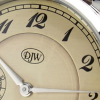-
Recently Browsing
- No registered users viewing this page.
-
Topics
-
Posts
-
Hello All, I’m looking for advice about how to interpret the mainspring specs described in the GR documents and in the catalogues of online sellers such as cousins. My problem relates to interpreting the value describing barrel size - I’m unsure what the last number REALLY refers to. For example: 1.10x.0105x360x11 (This refers to GR2628-X) Does the “ 11 “ here refer to the barrel inside diameter of the calibre OR to the diameter of the wound mainspring before insertion? For example if my measured barrel inside diameter to 11mm, I would normally select a wound spring size a little smaller, say 10.5, wouldn’t I? Or, does the barrel diameter described in the catalogue specifications take that into account and I would therefore order a catalogue size 11 for an 11mm barrel ID? Hope this makes sense. I can’t find clarification of this anywhere. Many thanks for any enlightenment. Cheers, John
-
By nickelsilver · Posted
Let's say, like in a watch, you have a 70 tooth 4th wheel, which needs to make a turn in one minute, with an 18,000 beat escapement. 15 tooth escape wheel as usual, and a 7 tooth pinion on it. 70 x 15 x 2 / = 300 That's 300 beats, and there are 5 beats per second, so divide and you get 60s, one minute- all is well. If we do 70 x 15 x 2 / 8 that equals 262.5. With an 18K balance, which will let the escape wheel move one turn in 6 seconds, the 4th wheel will have made like 1.14 turns. So the time display is running fast. But this comes to like 7.5 seconds over per minute, which is about double your gain (maybe I'm wrong- I'm mathing on my phone while writing on my phone 😄) but pretty sure the gain is more than you are observing. A possible culprit is that crown/4th wheel isn't running true, and a tooth is slipping past a pinion leaf once per revolution. I've seen this. If the platform is original and it's a nice piece they are often pinned, so the depthing isn't an issue. If the platform isn't pinned, check the depthing. And at any rate check the crown wheel between centeres and make sure the teeth are running true. -
Fast responses - thank you. Yes, I mentioned the 18000bph to illustrate that it's not a matter of touching coils, over banking, shortened hairspring etc. I even took off the platform and temporarily fitted a another NOS one also with 8 leaves and beating 18000 but the colossal gain is the same. I'm resigned to buying and fitting a new Gorge platform plus a 7 leaf pinion escape wheel but only if I think it will work; otherwise it's a waste of £200 and a couple of hours work. Hence the underlying question is: all other things being equal, what would the timekeeping effect be? Is it a simple 7/8ths as fast? Logic tells me it is but can it be that linear?
-
Sorry to jump in here guys, but I've read through this whole thread and it seems there are a lot of people who think joining Facebook means everyone will have access to their lives. You could make a Facebook account with a fake name. You could even use your real name if you wanted to and set it to completely private so people can't even find you in a search and you don't have to add anyone as a 'friend', so you won't see anyone's posts. Literally use it to join a group full of members of this site. Admins could even set the group to private and require a password of some sort to gain acceptance into the group, so you can be sure that it's only members of this site that get in. @tomh207 is right, the form with email addresses and names is a bad idea. That will be abused by scrapers. Facebook is only as personal as you let it be. You can be completely anonymous on there if you wish. Don't think of it as Facebook. Just think of it as a watch repair group as that's all you'd use the account for. It doesn't even have to be set up with your current email address. Make a random one on Gmail or any other free provider just for the Facebook account. Tagged you by accident and now it won't let me remove it 😂 @Neverenoughwatches
-
By RichardHarris123 · Posted
Hello and welcome from Leeds, England. Plenty of clock people on here to help you out.
-






Recommended Posts